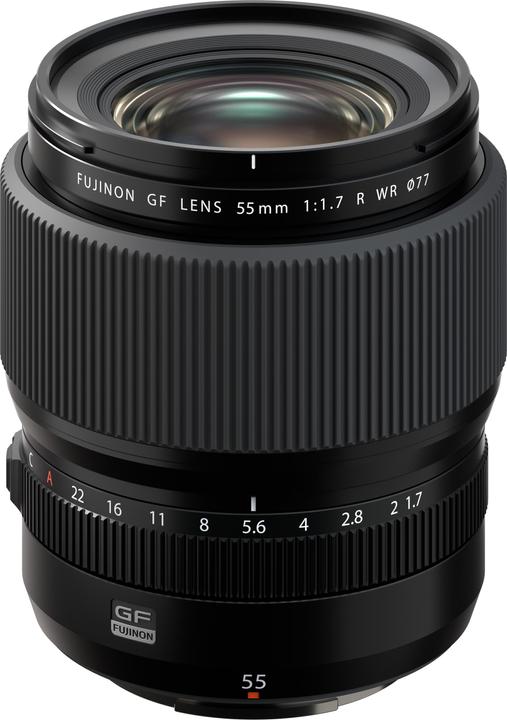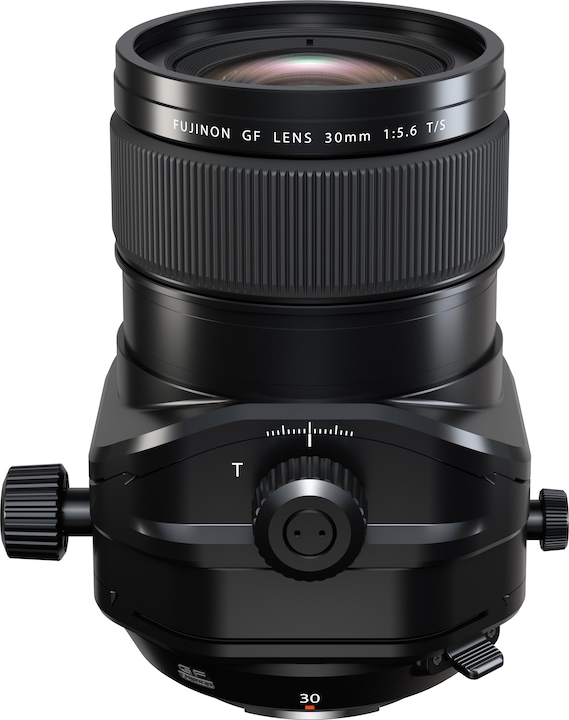

Fujifilm GFX 100 II review – the ultimate tool
Fujifilm’s new medium format camera is the most advanced of its kind. Like its predecessor, it has a resolution of 100 megapixels – and features several significant improvements.
For a long time, medium format cameras were like old Ferraris – beautiful and powerful, but also insanely expensive, prone to problems and lacking any assistance systems. In other words, impressive machines for professionals who know how to use them, luxurious toys for everyone else.
Four years ago, Fujifilm released the equivalent of a modern Audi: the GFX 100. At an introductory price of 12,000 Swiss francs, it was anything but cheap. But compared to models from Hasselblad and Phase One with similar image quality, Fujifilm’s camera was a real bargain. And unlike the purist competition, the GFX 100 came with modern conveniences such as phase-detection autofocus with face detection, an image stabiliser, and video functions. All this made it a small revolution.

Fujifilm has now introduced the successor model. The GFX 100 II is no longer a revolution, but an evolution. Its new form factor without a fixed vertical grip makes it appeal to a broader audience than the predecessor – as does the lower price of just under 7,600 Swiss francs. That’s 4,400 francs less than the GFX 100 at market launch, and less than the Hasselblad X2D currently costs.
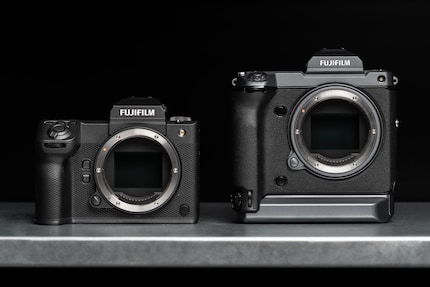
Source: Samuel Buchmann
Together with the camera, the Japanese company has also presented three new lenses. The Fujinon GF 55mm f/1.7 WR is a fast, standard lens. But much more interesting still are Fujifilm’s first tilt-shift lenses: the Fujinon GF 30mm f/5.6 T/S and the Fujinon GF 110mm f/5.6 T/S Macro. With them, the GFX system should become very attractive for architectural and product photography.
Even before the release, Fujifilm provided me with a test version of the GFX 100 II and the Fujinon GF 55mm f/1.7 WR. The hardware was final, the firmware not yet. This means the manufacturer could still improve smaller things before release. Throughout my review, I’ll point this out when applicable.
Design and specifications – a shrunken monster
The Fujifilm GFX 100 II looks like a tool. Its aesthetics fit into a studio between flash units and light stands. The casing is made of magnesium alloy protected with plastic. With the necessary lenses, the medium format system is still bulkier overall than a full-frame camera, even though the body alone isn’t much bigger.
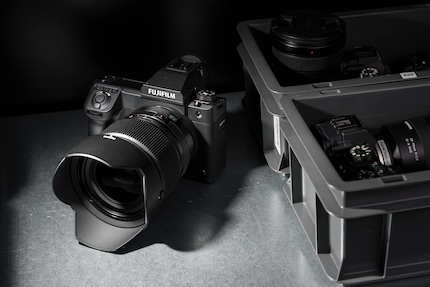
Source: Samuel Buchmann
The front and side of the GFX 100 II are covered with textured rubber. It offers better grip than the smoother material of the predecessor. The handle is large and fits comfortably in my medium-sized hand even after several hours of use. According to Fujifilm, the camera is weatherproof. I buy that given the clean processing. However, there’s no official IP certification.
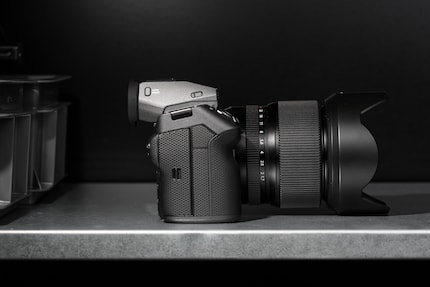
Source: Samuel Buchmann
I think leaving out the vertical handle was a good decision. As a result, the camera is more compact and almost 400 grammes lighter – although not quite as light as the GFX 100S, which weighs another 100 grammes less.
Here are the most important specifications:
The casing once again houses a back-illuminated, 43.8 × 32.9 millimetre CMOS sensor. This is a revised version of the predecessor that still comes with 100-megapixel resolution. Improved photodiodes and copper lines should offer more dynamic range.
What’s remarkable for a camera with such a large sensor is the continuous shooting speed. It shoots up to eight frames per second. In the old model, you got five. Unfortunately, the flash sync speed remains unchanged at 1/125 second. If you want to mix flash and bright ambient light, this can be a deal-breaking disadvantage. Most full-frame cameras manage 1/250 second. The gap is even greater compared to the Hasselblad X2D, which can be synchronised with a central shutter for shutter speeds up to 1/4,000 second.
Operation – complex, but convertible
Buttons – there are a lot of them on the GFX 100 II. For example, three above the shutter release and two on the front next to the handgrip. Many of them aren’t labelled. You can program them individually. The setting options in the menus also go deep; do you want manual or automatic viewfinder brightness? If automatic, maybe you’d like «+2», so it’s always a little brighter than the camera’s initial suggestion? This is just one of the countless options you get.
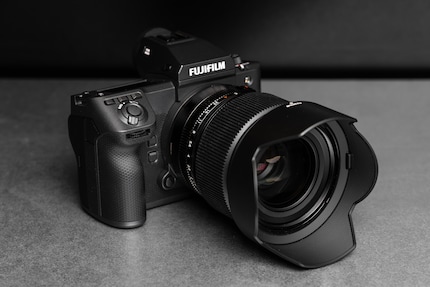
Source: Samuel Buchmann
This customisability makes operating the new GFX not particularly intuitive at first. I had to learn the ropes, program wheels and buttons, configure the camera in depth. The flip side? The controls are then perfectly tailored to me.
At the top of the camera is a gigantic display. In black and white, it displays the most important shooting parameters, even when the camera is turned off. During recording, I can choose to have a live histogram displayed instead. Since the display is angled back quite a bit, I can also glance at it while I’m taking pictures without having to put the camera down completely.
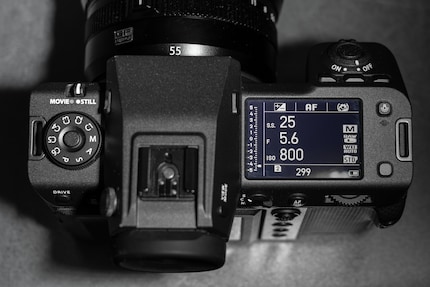
Source: Samuel Buchmann
All buttons have clear pressure points. The joystick’s resistance is greater than in the predecessor, which makes it feel more precise. The one thing that annoys me? When I want to push down the joystick to select something, it usually also tilts. As a result, I end up navigating away instead of selecting what I want. This would be fine if the dedicated «OK» button was located directly under the joystick. But it’s not. It’s a whole button further down.
According to Fujifilm, the five-axis in-body image stabilisation (IBIS) enables shutter speeds that are up to 8 stops slower. In the predecessor model, it was only 5.5 stops. I couldn’t reproduce this difference in my test. With both cameras, I manage handheld shutter speeds of 1/4 second with a 55mm lens. At 1/2 second, the shots become blurry – both with the GFX 100 and the GFX 100 II. Mind you, I can’t rule out that this will improve with the final firmware.
Viewfinder and display are top of the line
I can better experience the electronic viewfinder’s (EVF) leap in development. It has a resolution of over 9.44 million pixels (3.1 megapixels). This is a visible improvement over the GFX 100’s 5.76 million. The magnification has also increased – from 0.85x to 1.0x. Unlike with the budget GFX 100S, the GFX 100 II’s viewfinder is modular and can be replaced or fitted with the optional tilt adapter.
Overall, the GFX 100 II’s viewfinder is one of the best available. I can scale the size of the image in steps. Even though this reduces the resolution, it’s a blessing for eyeglass wearers like me who can’t press their eye as close to the viewfinder as people without glasses. In many viewfinders, I can’t see all the way to the corners.
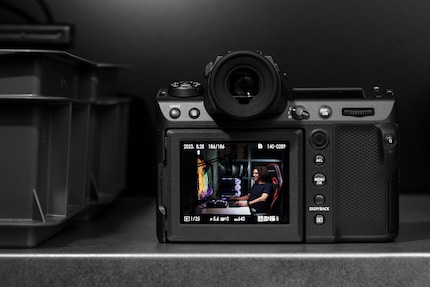
Source: Samuel Buchmann
When it comes to the 3.2-inch display on the back, nothing has changed. And there was no need for it to change either, because the resolution of 2.36 million pixels as well as the brightness are good. The display can be tilted on two sides, but not folded out. A shame, but not a dealbreaker on a camera that isn’t meant for vlogging.
Autofocus – not perfect, but a milestone
The Achilles heel of medium format cameras has always been the autofocus. The GFX 100 II changes that. Granted, no one will ever rely on it to take pictures at the Olympics; it’s too slow for that. For other applications like portrait photography, however, Fujifilm has set a milestone. The GFX 100 II is the first medium format camera to have an autofocus that I would describe as fully fledged and suitable for everyday use, even for moving subjects.
Compared with the predecessor, I particularly notice the better eye tracking. The GFX 100 II sets smaller focus areas that lie more precisely on the eyes – even at the edge of the image. I shoot some test portrait shots. In the dark basement, I illuminate my colleague Philipp Rüegg with a studio flash. I turn off the rest of the lights , including the modelling light of the flash. Even so, I can leave the focusing to the automatic system, and it hits every time. I don’t have any rejects due to bad focus.
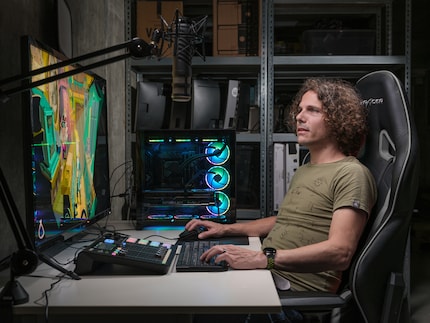
Source: Samuel Buchmann
Only in the backlight of a window does the tracking sometimes get confused and catch the pink chair instead of my colleague Michelle Brändle’s eyes. Switching to a single autofocus zone and placing approximately on the face helps against this. Every single image is then sharp, even with a large aperture. Impressive and very useful. It leaves me more room to focus on the light, composition and subject.
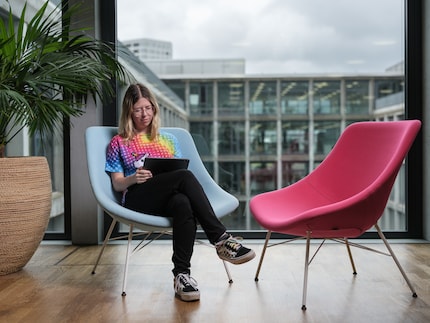
Source: Samuel Buchmann
I didn’t try the tracking modes for animals, cars and so on. I’m not a fan of autofocus on generic objects. It somehow never gets right what I want to be sharp. This is anecdotal evidence, mind you, but my reference system from Sony appears more intelligent. With the GFX 100 II, I prefer to switch to manual focus when photographing things other than people.
Even then, full-frame cameras are faster and more decisive. The autofocus of Fujifilm’s behemoth sometimes goes on a bit of a hunt before settling on its target. It especially tends to struggle in continuous shooting mode. But at least there’s a continuous mode at all, which can’t be said for the competition from Hasselblad. And it’s possible that Fujifilm will still improve the autofocus with the final firmware.
Picture quality is a dream
Photography nerd alert: the sensor of the Fujifilm GFX II is an absolute dream! It’s outstanding in every respect. In image development, the files feel like they have more depth than those from full-frame cameras. This may sound airy-fairy, but it isn’t. There are rational reasons for this perception:
- 100-megapixel resolution: looking at a photo from the GFX 100 II, I can zoom in endlessly and get lost in it. The new Fujinon GF 55mm f/1.7 maintains sharpness even in the corners. Overall, this combination results in much finer details than a full-frame system.
- 16-bit colour depth and high dynamic range: the gradients from highlights to shadows are finely graduated and soft. In image processing, I have more scope for colour and tonal value corrections with photos from the GFX 100 II than with photos from any other camera under 20,000 francs.
- Harmonious colours: Fujifilm’s colour profiles are just behind Hasselblad’s in my personal ranking. For portraits, I particularly like the understated «PRO Neg. Std». It makes skin tones look natural and balanced.
- Excellent noise performance: in the 100 per cent view, the graininess is comparable to that of other cameras. But as soon as I scale the images to the same size, the GFX 100 II shows an advantage.
- 4:3 aspect ratio: medium format cameras shoot in this aspect ratio instead of the more common 3:2. I find this more aesthetically pleasing and handy – especially in portrait format. It also makes more sense technically; lenses provide a circular image. With this aspect ratio, less of it is lost.
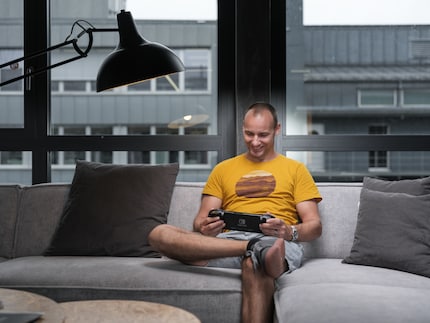
Source: Samuel Buchmann
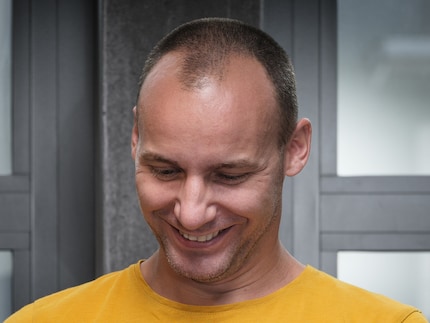
Source: Samuel Buchmann
Fujifilm states 30 per cent more dynamic range compared to the GFX 100. I’m not sure exactly how this was determined. One possible interpretation: dynamic range is measured in f-stops. Each step corresponds to a doubling. Photons to Photos measures a good 12.2 stops for the first GFX 100, which is a top value. As I understand it, 30 per cent more would be about 12.5 stops. But I have no measuring method to verify this scientifically.
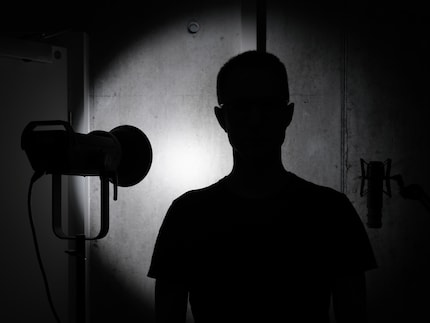
Source: Samuel Buchmann
As a rough test, I photograph myself against the light in front of a brightly illuminated wall. With the GFX 100 II, I can in fact extract some more detail out of the dark and bright areas than with the predecessor, around the centre of the light cone and on the face. Colours are also better preserved in the shadows.
Other than that, I don’t see any difference between the new sensor and the «old» version in the Fujifilm GFX 100 and GFX 100S. It’s insignificant. These two cameras already delivered bomb image quality. Whether you really need this in everyday life depends on your application. RAW files are fun in any case. But you need enough computing power for image processing as well as a lot of storage space – an uncompressed image takes up over 200 megabytes.
Video – good, but not the best
Filming in medium format is fundamentally difficult. Because the sensors are large, their readout rate is low. That’s why, despite the high photo resolution, the old GFX 100 only had 4K video – with line skipping and pixel binning. In other words, the video quality was okay, but not better than on an average full-frame camera, the latter also offering faster autofocus.
What’s the situation with the GFX 100 II? It can do 8K at up to 30 fps in 10-bit 4:2:2. At this resolution, the image quality can compete with other 8K cameras. Fujifilm’s flat F-Log2 colour profile captures plenty dynamic range. I can convert the recordings with LUTs to either Rec.709 or Eternea. The latter gives the skin tones a warm hue that I like.
In 8K, however, the GFX 100 II doesn’t capture the image with the full sensor. It applies a 1.51-fold crop. The camera also needs 32 milliseconds to read out the frames. Full-frame BSI sensors with comparable pixel density are similarly slow. 32 milliseconds means a pronounced rolling shutter effect. With 4K in 30 and 60 fps, the readout speed is faster and there’s no more crop either. In these modes, the image is less detailed.
The autofocus of the Fujifilm GFX 100 II is less suitable for videos than for photos. Yes, it reliably finds my eye in my test shots and is usually accurate. But when I move, the camera shifts focus rather jerkily. It often overshoots the mark and has to restabilise. For professional video recording, this kind of focus hunt game is useless. You’d need the sharpness to be on point immediately and to shift more smoothly. Full-frame models are better at that.
If you want to primarily shoot video, there are better cameras than the GFX 100 II. But the GFX 100 II is well suited for mixed projects, for example, if you want to shoot portraits and also film an interview.
The verdict – a fully fledged high-end camera
The Fujifilm GFX 100 II is a great camera for portrait, architecture and product photography. And, depending on priorities, also for reportage and landscape work. The 100-megapixel images offer very fine details, a lot of dynamic range and a vast colour depth. The files offer more freedom in image development than those from conventional cameras. Compared to the old version of the sensor, there’s not much improvement in photo quality. On the other hand, video quality has improved significantly. Only the rolling shutter remains a limitation when shooting in 8K.
Compared to the predecessor, the camera is easier to handle while maintaining its sophisticated operation. It does take some getting used to because of its complexity, with the advantage that you can adapt it to your preferences. The good ergonomics, the gigantic top display and the high-resolution electronic viewfinder are also a joy.
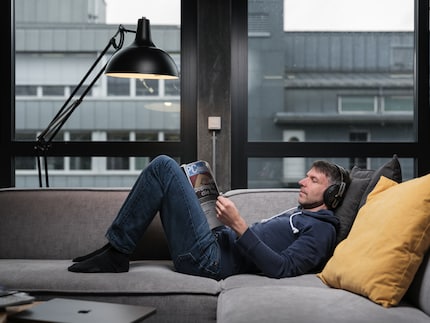
Source: Samuel Buchmann
However, the biggest unique selling point of the GFX 100 II is its autofocus. The behemoth of a camera doesn’t focus as quickly and decisively as a modern full-frame camera. But it’s the first medium format model with eye tracking that I can trust. In portrait photography, this frees the mind for other things. Only with fast-moving subjects does the autofocus reach its limits. The same goes for videos, where the focus tracking isn’t very smooth.
Finally, a look at alternatives: Fujifilm’s own GFX 100S is less expensive and takes equally excellent photos, though you have to make sacrifices in terms of autofocus, operation, the electronic viewfinder and video. And the Hasselblad X2D? It’s part of a totally different concept. The overall system is more expensive and comes with more restrictions – the Swedish company has yet to deliver on the promised eye tracking one year after release. In return, the X2D has a leaf shutter, is more compact and has a more refined feel. It’s an exquisite instrument. The Fujifilm GFX 100 II, on the other hand, is the ultimate tool.
My fingerprint often changes so drastically that my MacBook doesn't recognise it anymore. The reason? If I'm not clinging to a monitor or camera, I'm probably clinging to a rockface by the tips of my fingers.
